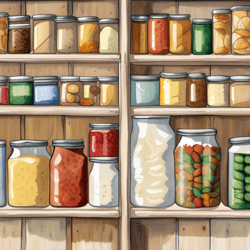
Suppose you're among the throngs of allergy sufferers or health enthusiasts who've grappled with mysterious discomfort. In that case, "histamine" may have cropped up a time or two in your online searches or conversations with healthcare professionals. But what exactly is it, where does it lurk, and how can you control it in your diet?
Understanding histamine and its potential effects is pivotal for those wishing to fine-tune their eating patterns to optimize their well-being. This comprehensive guide is your ticket to dismantling the enigma of histamine and discovering which culinary delights may contribute to unwanted symptoms. Here, we'll deeply dive into what histamine is, what high-histamine foods to watch out for, and how to curate a diet that suits your sensitivities.
Understanding Histamine Intolerance
When the body's natural balance is disrupted, histamine levels can surge, leading to intolerance. Various factors, including gut health, medication, and genetics, can cause this imbalance.
The Symptoms: From unexplained rashes to an unpredictable runny nose, histamine intolerance can manifest in numerous ways, often mimicking other allergies or intolerances. Common symptoms include:
• Flushing
• Hives
• Itching
• Headaches
• Digestive issues
• Irregular menstrual cycles
• Fatigue
The Culprits: High histamine foods are usually at the top of the list of potential triggers. But what are these foods, and how can you identify them amidst your grocery haul?
Identifying High Histamine Foods
A keen eye on food labels can make all the difference. But what exactly should you be looking for?
Common Offenders: Some of the staple foods we turn to daily could be the cause of our discomfort:
• Aged cheeses
• Cured meats
• Shellfish
• Eggs
• Fermented foods like sauerkraut
• Certain vegetables like spinach and tomatoes
The Labels: Understanding the often inconspicuous language of ingredient lists is key. Terms such as 'fermented,' 'aged,' and 'pickled' should pique your interest as potential triggers.
Fresh Isn’t Always Safe: Even seemingly harmless fresh produce can release histamine if not stored or handled correctly. Buying and consuming fresh is a start, but proper storage and swift consumption are crucial.
Managing Histamine Intolerance
Play Around with Preparation:
Fresh is Best: Opt for the freshest fare you can find. High histamine foods become drama queens when aging but are much easier to tame when picked or bought recently.
Cook Them Differently: The cooking process can modify the histamine content in certain foods, so experiment with steaming, boiling, or frying to see how it affects your tolerance.
Crafting a Personalized Pantry and Fridge Inventory
Building a cohesive and comforting histamine-savvy store of foods is a labor of love – and label reading. Take the time to familiarize yourself with low-histamine alternatives, and stock up smartly.
Low-Histamine All-Stars:
Poultry and Seafood: Fresh and carefully processed are your allies here.
Grain Gurus: Quinoa, millet, and white rice are low in histamines.
Veggie Victory: Most vegetables are low in histamine, except a few, like tomatoes and spinach.
A well-stocked fridge and pantry supporting a low-histamine lifestyle simplifies meal planning and encourages success in your altered eating adventure.
The Top Shelf in Your Cart:
Fresh fruits and vegetables, garlic-infused oils, and a medley of smooth nut butter can elevate your low-histamine palate.
Enlist the help of refrigeration to keep histamines in check with fresh meats, dairy, and leftovers.
In wrapping up, we dove deep into the realm of high-histamine foods that often lurk unnoticed in our pantry and fridge. Understanding these can be critical to managing health, particularly for those susceptible to histamine intolerance. By identifying and moderating the consumption of such foods, you can alleviate discomfort and support your well-being. Remember, knowledge is power when it comes to your diet. Empower yourself with this information, and consider consulting a healthcare professional if you suspect histamine-rich foods are impacting your health.
The information provided in this article is for general knowledge only and should not be considered medical advice. It is always best to consult a healthcare professional before changing your diet or lifestyle. So remember, while staying hydrated is crucial for a healthy gut, it should be done in moderation and according to individual needs. Stay informed and stay healthy! 🌱😊

Dive into the pages of my new book, 'A Little Book Of Gut Wellness' — your comprehensive guide to nurturing and nourishing your gut for overall well-being! Click here to get your copy today.


